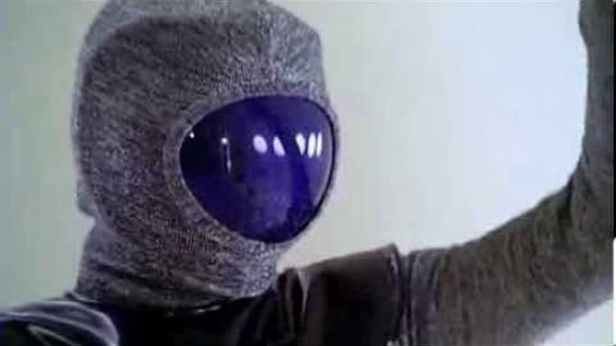Mario Gariazzo’s outrageously silly science fiction epic – also known as The Eyes Behind the Stars – is set in a fantasy England that looks, sounds, works and behaves in ways that the real England never has. Gariazzo wrote and directed this nonsense under his usual pseudonym, Roy Garrett who, according to an on-screen statement was a “member of the National Committee on Aerial Phenomena (N.I.C.A.P.) and field researcher of the Ariel Phenomena Research Organisation of the United States of America.” Gariazzo, it seems, really was a prominent Italian UFOlogist, which makes his ham-fisted treatment of his pet subject here all the more regrettable.
Photographer Peter Collins (Franco Garofalo, one of the inept marines in Bruno Mattei and Claudio Fragasso’s Virus/Hell of the Living Dead/Zombie Creeping Flesh (1980))) and model Karen (the American actress Sherry Buchanan, possibly best known for having her vocal chords snipped in Zombi Holocaust (1980) are on a shoot in the woods when his watch stops and her radio goes haywire. When he processes his shots, Peter spots something mysterious and possibly alien in the background and returns to the woods looking for evidence. He’s abducted by aliens who probe his mind, get the hots for Karen and abduct her too. It’s up to the unlikely trio of reporter Tony Harris (Robert Hoffman), secretary Monica Styles (Nathalie Delon) and antique dealer turned UFOlogist Coleman Perry (Victor Valente) to find the missing abductees and expose a government cover-up. Standing against him is Inspector Jim Grant (Martin Balsam, sporting a strange Yorkshire dub – everyone else is terribly posh) of Scotland Yard and some sinister men in black.

The aliens, decked out in fetching silvery one-pieces with helmets/masks that make them look like cyclopses, pootle about in a terrible flying saucer that Gariazzo wisely keeps hidden for much of the time. We get some feeble blue-tinted fish-eye lens shots representing the aliens’ point of view (how they manage to do anything if their eyesight is that murky is beyond me) and lots of rubbish bleeps and farts from Marcello Giombini’s synthesizers. It’s all par for the low budget course really and, as is so often the way with this sort of thing, we never do actually find out what the aliens are actually up to. They abduct and kill a few people but their overall masterplan remains rather sketchy.
Unable to afford expensive special effects, and seemingly limited to the number of locations he had at hand, Gariazzo has his characters spend an awful lot of time sitting around yakking when they might have been more useful getting out and doing a bit of investigating. In the too-little-too-late final stages, Harris decides to give it a go, briefly transforming into a mid-tier action hero for an unconvincing bit of last minute derring-do that leads to a downer of an inconclusive ending. But to get there we have to suffer interminable lectures from tedious people delivering great gobs of uninteresting exposition.

Given Gariazzo’s alleged expertise in the area, it’s astounding that he couldn’t come up with something more dynamic than this. Being strapped for cash is no excuse for having people wander around, chat endlessly about things that aren’t all that important and emoting wildly and at times inappropriately – people tend to get ridiculously angry over the slightest little thing for example. The characters are less than paper thin and the aliens, despite their early appearances, barely figure in the plot at all. Gariazzo was a typical Italian director, dabbling in all manner of genres without really making an impact upon any of them. He may be best known for saucy crime thriller Play Motel (1979) but he stuck around science fiction for two more offerings, both of them as dull as Occhi dalle stelle – Incontri molto… ravvicinati del quarto tipo/Very Close Encounters of the Fourth Kind (1978) and Fratello dello spazio/Brother from Space (1988).